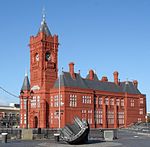Cardiff Harbour Authority
2000 establishments in WalesOrganisations based in CardiffTransport in CardiffUse British English from March 2017

Cardiff Harbour Authority (CHA) is the managing authority for Cardiff Bay under the Cardiff Bay Barrage Act 1993, and was established on 1 April 2000. It took over responsibility from Cardiff Bay Development Corporation and is responsible for the inland bay, Cardiff Bay Barrage, the outer harbour and the rivers Taff and Ely. The harbour authority is part of the City of Cardiff Council and is the statutory navigation authority for Cardiff Bay. The authority is funded by the Welsh Government.
Excerpt from the Wikipedia article Cardiff Harbour Authority (License: CC BY-SA 3.0, Authors, Images).Cardiff Harbour Authority
Locks Road, Cardiff Butetown
Geographical coordinates (GPS) Address Nearby Places Show on map
Geographical coordinates (GPS)
| Latitude | Longitude |
|---|---|
| N 51.453181 ° | E -3.161161 ° |
Address
Queen Alexandra House
Locks Road
CF10 4GA Cardiff, Butetown
Wales, United Kingdom
Open on Google Maps











